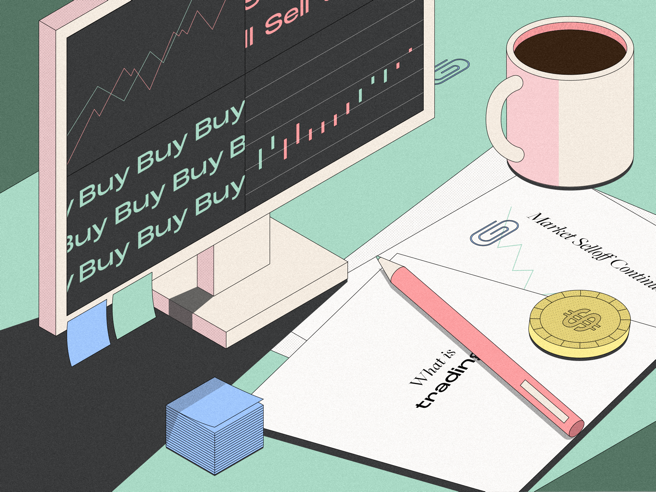Occasionally we’ll link out to relevant products that could be useful to our readers. Learn more about us here.
Index funds are a low-barrier, low-cost way for investors to buy a group of diversified securities with one purchase. As an investment, an index fund has two main components. First, it’s a type of mutual fund, which pools money from a group of people to invest in a portfolio of different stocks, bonds and other securities. Second, the securities within an index fund are selected to mimic a benchmark index, which is a group of securities used as a standard for evaluating the performance of a particular market segment, such as the S&P 500 in the U.S. or the S&P/TSX Composite Index in Canada.
Since index funds first appeared in the 1970s, they have grown into a popular investing option in part because a lot of research has shown that active funds–portfolios where a manager chooses stocks–rarely outperform their benchmark, with many even underperforming. If that’s the case, then why pay a manager high fees when you can buy something that requires no stock-picking yet can still generate good returns?
What is an index fund?
In 1976, Vanguard, a now global investment firm that popularized the idea of passive investing, introduced the Vanguard 500 Index Fund, the world’s first index product. The fund is still around today and tracks the S&P 500, a benchmark index made up of the 500 largest publicly-traded companies in the U.S. Buying shares in each of these companies separately would take a lot of time, money and effort compared to buying a share in an index fund.
Index funds follow a passive investment strategy called “indexing,” which aims to replicate a benchmark index as closely as possible by holding the same stocks in the same proportions. The goal of an index fund is to be inexpensive and tax-efficient.
Unlike actively managed investments, index funds have low portfolio turnover. The allocation only changes when there are changes in the benchmark it tracks. For example, if a benchmark index rebalances the weighting of securities within it, an index fund will adjust its own holdings to reflect that change.
Today, there are thousands of different types of index funds that track major stock market indexes such as the Dow Jones Industrial Average and the S&P/TSX Composite Index, as well as international markets. Index funds can also be very granular and track indexes that focus on specific industries or sectors, market capitalization, geography, currency, asset classes and more.
Are index funds a good investment?
Whether or not index funds are a good fit for your overall portfolio depends on a few factors such as your risk tolerance, time horizon for investing, and how hands-on you want to be with your portfolio. Like all investments, there are a few things to consider before buying index funds.
Index fund advantages
Diversification: Index funds give the average person access to a well-rounded assortment of securities bundled into one package. Individual investors can target a wide range of industries, companies, asset classes and foreign markets with less time and effort and they don’t need to know anything about assembling a portfolio of individual stocks.
Lower fees, expenses and taxes: Index funds do have a portfolio manager, but their job is less laborious than the average mutual fund because they use a benchmark index as a guide. With a passive investment strategy that involves lower operating expenses and portfolio turnover, investors pay overall lower fees. However, with so many different types of index funds out there, not all index funds are equal in terms of costs.
Index fund disadvantages
Harder to buy and sell: Compared to individual stocks, mutual funds have less trading flexibility. Stocks and exchange-traded funds (ETFs) fluctuate in price and trade throughout the day, but index funds only be bought and sold after the markets close and are priced based on their daily net asset value.
No control over investment choices: You can choose which index fund you want to invest in, but the fund’s portfolio manager is the one who picks stocks and sets allocations. The goal is to construct a fund similar to a benchmark index, but this passive investment strategy may not be appealing to those who want to be more active in choosing what goes into their portfolio.
Types of index funds
There are thousands of different index funds out there that give investors exposure to a variety of industries, assets, currencies and international markets. This list doesn’t cover every single one, but here are the most common types of index funds.
Total market index fund
This type of fund aims to replicate the broad market by tracking equities indexes such as the S&P/TSX Composite Index in Canada, and indexes in the U.S. such as the S&P 500, the Dow Jones Industrial Average and the Nasdaq 100. Total market index funds can also track foreign benchmark indexes.
Sector index fund
Sector index funds follow benchmark indexes that track the performance of specific industries, such as oil and gas, pharmaceuticals, financials, technology, energy, health care, consumer staples, technology, utilities, real estate, materials and industrials. Sectors themselves can be broad or specific.
Equity index fund
Equity index funds are a broad category, and can be broken down by focusing on stocks that meet certain metrics such as market capitalization (the total dollar value of a company’s outstanding shares of stock), value, growth, profitability or country/region.
Dividend index fund
An index fund built around securities with income generating potential. This type of index fund collects the dividends and distributes them as a single payout to investors on a scheduled basis, such as monthly or quarterly.
International index funds
International index funds track benchmark indexes located outside of Canada, making it possible to invest in foreign stocks in both developed and emerging or frontier economies. International index funds can focus on a specific country or region, or hold a handful of securities from around the world. International funds can also use currency hedging, which is when a fund invests in a number of different currencies to offset the effect of fluctuations. For example, a fund may hold a basket of stocks traded in the U.S. dollar, Euro, British sterling pound, Australian dollar, Swiss francs and Japanese yen.
Bond index funds
This type of index fund holds a basket of bonds that align with a specific bond index, such as government, municipal or corporate bonds. For example, the S&P 500 Bond Index is the corporate bond version of the S&P 500. Bond index funds can hold a basket of bonds with different investment strategies and both short-term holding periods (stable returns) and long-term holding periods (strong returns).
Index funds vs. mutual funds
An index fund is a type of mutual fund, and functions the same way in terms of buying and selling. The main difference is that it follows a pre-determined benchmark, while mutual funds are overseen by portfolio managers who pick and choose what stocks to include in a fund with the goal of outperforming the broader market. Index funds are still overseen by a human, but they involve less research, analysis and overall effort because they’re built to track an index and replicate similar returns.
ETF vs. index funds
An exchange traded fund (ETF) consists of a diversified portfolio of stocks, bonds and other investments bundled into a single purchase. Like stocks, ETFs are bought and sold in shares on exchanges throughout the trading day. ETFs are passive investments designed to mirror benchmark indexes, so they have lower portfolio turnover and lower expenses.
Index funds and ETFs are similar, and both offer investors a way to buy a diversified bundle of assets that track a number of different benchmark indexes. Both types of investments can be part of a portfolio, but there are a few key differences between how the two work.
Purchasing: Index fund units are usually purchased in set dollar amounts. ETFs are sold in shares, like stocks.
Costs: Mutual funds are actively managed by a portfolio manager, and charge annual fees and commissions for those services. ETFs are, generally, programmed by algorithms to track an index, so no fees are paid to a portfolio manager. Index funds are more passively managed and less expensive than the average mutual fund, but they still tend to be more expensive than ETFs.
Transparency: Index funds are less transparent, as mutual funds are only required to disclose their holdings once a quarter. ETFs publish a full list of their investment holdings daily.
Trading: Index fund units can only be purchased at the end of the day, after the markets close, and are priced based on their net asset value. ETFs can be bought and sold at any time throughout the trading day, and share prices may fluctuate.
Taxes: Both index funds and ETFs are considered fairly tax efficient investments. However, ETFs are generally considered the more tax efficient choice because of how shares are bought and sold. ETFs are sold on exchanges like stocks, and can change hands between investors without triggering capital gains. Index fund units are always purchased from and sold back to the fund itself. When an investor sells their index fund units, the fund must sell securities to raise cash to cover that amount, which may trigger taxes for the entire fund.
How to buy index funds
Like other types of mutual funds, index funds can be purchased directly from mutual fund companies, banks or credit unions, through your financial advisor or a robo-advisor, or by using an online brokerage account.
If you’re ready to invest in index funds, here’s how to do it:
1. Select an index fund
You can invest in more than one index fund, but even buying into a single fund that tracks a broad market index like the S&P 500 will give you exposure to a wide range of different market segments. You can tailor your portfolio to target specific sectors or industries such as technology, healthcare, precious metals, energy, transportation and consumer staples, as well as emerging or growth sectors.
You can also choose index funds based on company size and capitalization (called small-, mid- or large-cap indexes), asset class (stocks, bonds, commodities, cash), or by country/region, currency or a combination of international indexes.
Think about your time horizon and risk tolerance, as well as investment minimums, management fees and withdrawal rules. Based on your personal criteria, you can filter out different types of index funds based on what’s important to you.
2. Decide how you want to invest
You can buy and sell your own index funds by setting up a trading account through a robo-advisor or discount brokerage or get investment advice from a financial advisor. Each investing approach has different costs associated with trading, advising and managing your account. Here’s what you should know about each one.
Automated: Robo-advisors offer a set-it-and-forget-it approach by asking you a few questions, assessing your risk profile and using algorithms to appropriately invest your money. You’re normally invested in a broad section of the market, such as in Canada, the U.S. and international stocks. Robo-advisors have low opening balance requirements and are inexpensive, with fees much lower than the cost of a financial advisor (0.4%-1% of your investments). Robo-advisors often require little human interaction, but many platforms provide some financial advice in the form of online tools or access to a financial advisor. They’re advantageous for hands-off investors who don’t want a DIY investment portfolio.
Trade stocks commission-free and get a $10 cash bonus
Open a Wealthsimple Trade account to buy and sell thousands of stocks and ETFs commission-free. You’ll get a $10 cash bonus when you join.
Terms and conditions apply.
DIY: A discount brokerage is much more hands-on. You can pick your own stocks, bonds or funds and, as the name suggests, trading fees are low (from between $0-$10 per trade depending on the institution). They can be a good fit for investors who want to trade frequently, though trading fees can add up. Discount brokerages don’t offer any financial advice.
Financial advisor: A financial advisor is someone who provides financial planning advice and can, in many cases, invest money on your behalf. Financial advisor fees are generally higher than a robo-advisor or a discount brokerage–often 1% to 2% of the assets they manage. Now that there are more low-cost options for investors, some financial advisors are only taking on higher net worth clients, often those with investable assets of $100,000 or above. Still, there are many advisors who will work with people across the income spectrum. They can be useful if you have a complicated financial situation, or if you need help budgeting.
3. Place your order
Index fund shares are called units, and can only be purchased at the end of the trading day. In North America, markets trade Monday to Friday between 9:30 a.m. and 4:30 p.m. EST. When you enter a trade to buy index fund units, it will be processed at the next available net asset value, which is the per-share value of a fund’s assets, minus its liabilities. After the markets close, the daily net asset value is usually calculated and posted by 6 p.m. EST.
If you have a self-directed portfolio through an online brokerage, you can browse and compare the available index funds to make sure you’re comfortable with investment minimums, account minimums and the fund’s expense ratio and fee structure. Index funds are purchased in set dollar amounts, so you can place an order through your brokerage account by choosing the fund, entering the amount of money you want to invest, and clicking “buy.”
How to sell index funds
If you invest through a robo-advisor or financial planner, you’ll need to go through them to sell any investments. If you use a self-directed online brokerage account, you can execute a sale just about as easily as you place an order to buy. Before selling your index funds, there are a few things to consider.
Timing: Like all mutual funds, index fund units can only be sold at the end of the trading day. It’s important to remember that index funds follow a passive investment strategy, and don’t trade like stocks or ETFs. Index funds are meant to replicate the returns of a benchmark index, not beat it. Because of this, index funds are better suited to investors with a longer investing horizon who plan to utilize a buy-and-hold strategy.
Costs: Before placing your trade, familiarize yourself with the exact fees and commissions your brokerage charges for buying and selling index funds. Some mutual funds charge a front-end load, a fee charged when you buy an index fund, while back-end loads are paid when you sell your shares. Other transaction fees may apply.
Taxes: Because index funds are constantly buying and selling stocks as investors buy and sell units in the fund, it triggers taxable events for all of the fund’s investors. If you hold an index fund outside of a registered retirement savings plan (RRSP), a tax-free savings account (TFSA) or other accounts where money is allowed to grow either on a tax-deferred or tax-free basis, you’ll be taxed on any income the fund distributes to you. When you sell the shares, you’ll be taxed on any gains.
When you buy and sell index funds through a brokerage account or any type of unregistered account, you’re liable for taxes on dividends, capital gains, interest and any foreign income (including foreign tax owed).
Like ETFs, index funds are an efficient way to access a basket of securities with one purchase. Unlike buying a traditional mutual fund, index funds can provide you with diversification at a lower cost. Because they track an underlying financial market index, index funds minimize risk while potentially achieving decent returns.











